1. Vernon G, Baranova A, Younossi ZM. Systematic review: the epidemiology and natural history of non-alcoholic fatty liver disease and non-alcoholic steatohepatitis in adults. Aliment Pharmacol Ther. 2011; 34(3):274–285. PMID:
21623852.

2. Cho HC. Prevalence and factors associated with nonalcoholic fatty liver disease in a nonobese Korean population. Gut Liver. 2016; 10(1):117–125. PMID:
26260755.

3. Choi SY, Kim D, Kim HJ, Kang JH, Chung SJ, Park MJ, et al. The relation between non-alcoholic fatty liver disease and the risk of coronary heart disease in Koreans. Am J Gastroenterol. 2009; 104(8):1953–1960. PMID:
19491838.

4. Zhang T, Zhang C, Zhang Y, Tang F, Li H, Zhang Q, et al. Metabolic syndrome and its components as predictors of nonalcoholic fatty liver disease in a northern urban Han Chinese population: a prospective cohort study. Atherosclerosis. 2015; 240(1):144–148. PMID:
25785362.

5. Jung JY, Park SK, Oh CM, Chung PW, Ryoo JH. Non-alcoholic fatty liver disease and its association with depression in Korean general population. J Korean Med Sci. 2019; 34(30):e199. PMID:
31373184.

6. Ramesh S, Sanyal AJ. Evaluation and management of non-alcoholic steatohepatitis. J Hepatol. 2005; 42 Suppl(1):S2–S12. PMID:
15777569.

7. Schindhelm RK, Diamant M, Dekker JM, Tushuizen ME, Teerlink T, Heine RJ. Alanine aminotransferase as a marker of non-alcoholic fatty liver disease in relation to type 2 diabetes mellitus and cardiovascular disease. Diabetes Metab Res Rev. 2006; 22(6):437–443. PMID:
16832839.

8. Utzschneider KM, Kahn SE. Review: the role of insulin resistance in nonalcoholic fatty liver disease. J Clin Endocrinol Metab. 2006; 91(12):4753–4761. PMID:
16968800.
9. Kim JY, Cho J, Yang HR. Biochemical predictors of early onset non-alcoholic fatty liver disease in young children with obesity. J Korean Med Sci. 2018; 33(16):e122. PMID:
29651819.

10. Radcke S, Dillon JF, Murray AL. A systematic review of the prevalence of mildly abnormal liver function tests and associated health outcomes. Eur J Gastroenterol Hepatol. 2015; 27(1):1–7. PMID:
25380394.

11. Rafiq N, Younossi ZM. Nonalcoholic fatty liver disease: a practical approach to evaluation and management. Clin Liver Dis. 2009; 13(2):249–266. PMID:
19442917.

12. Fraser A, Ebrahim S, Smith GD, Lawlor DA. A comparison of associations of alanine aminotransferase and gamma-glutamyltransferase with fasting glucose, fasting insulin, and glycated hemoglobin in women with and without diabetes. Hepatology. 2007; 46(1):158–165. PMID:
17596883.

13. Zhang Y, Lu X, Hong J, Chao M, Gu W, Wang W, et al. Positive correlations of liver enzymes with metabolic syndrome including insulin resistance in newly diagnosed type 2 diabetes mellitus. Endocrine. 2010; 38(2):181–187. PMID:
20972737.

14. Vozarova B, Stefan N, Lindsay RS, Saremi A, Pratley RE, Bogardus C, et al. High alanine aminotransferase is associated with decreased hepatic insulin sensitivity and predicts the development of type 2 diabetes. Diabetes. 2002; 51(6):1889–1895. PMID:
12031978.

15. Hagström H, Höijer J, Ludvigsson JF, Bottai M, Ekbom A, Hultcrantz R, et al. Adverse outcomes of pregnancy in women with non-alcoholic fatty liver disease. Liver Int. 2016; 36(2):268–274. PMID:
26114995.

16. Yarrington CD, Cantonwine DE, Seely EW, McElrath TF, Zera CA. The association of alanine aminotransferase in early pregnancy with gestational diabetes. Metab Syndr Relat Disord. 2016; 14(5):254–258. PMID:
26959309.

17. Lee SM, Kwak SH, Koo JN, Oh IH, Kwon JE, Kim BJ, et al. Non-alcoholic fatty liver disease in the first trimester and subsequent development of gestational diabetes mellitus. Diabetologia. 2019; 62(2):238–248. PMID:
30470912.

18. Lee SM, Kim BJ, Koo JN, Norwitz ER, Oh IH, Kim SM, et al. Nonalcoholic fatty liver disease is a risk factor for large-for-gestational-age birthweight. PLoS One. 2019; 14(8):e0221400. PMID:
31449538.

19. Committee on Practice Bulletins--Obstetrics. Practice bulletin No. 137: gestational diabetes mellitus. Obstet Gynecol. 2013; 122(2 Pt 1):406–416. PMID:
23969827.
20. Alberti KG, Zimmet PZ. Definition, diagnosis and classification of diabetes mellitus and its complications. Part 1: diagnosis and classification of diabetes mellitus provisional report of a WHO consultation. Diabet Med. 1998; 15(7):539–553. PMID:
9686693.

21. American Diabetes Association. Standards of medical care in diabetes--2013. Diabetes Care. 2013; 36(Suppl 1):S11–S66. PMID:
23264422.
22. American College of Obstetricians and Gynecologists. Task Force on Hypertension in Pregnancy. Hypertension in pregnancy. Report of the American College of Obstetricians and Gynecologists' Task Force on Hypertension in Pregnancy. Obstet Gynecol. 2013; 122(5):1122–1131. PMID:
24150027.
23. Yarrington CD, Cantonwine DE, Seely EW, Mcelrath TF, Zera CA. The association of early unexplained elevated alanine aminotransferase with large-for-gestational-age birthweight. Am J Obstet Gynecol. 2016; 215(4):474.e1–474.e5. PMID:
27173083.

24. De Souza LR, Berger H, Retnakaran R, Vlachou PA, Maguire JL, Nathens AB, et al. Non-alcoholic fatty liver disease in early pregnancy predicts dysglycemia in mid-pregnancy: prospective study. Am J Gastroenterol. 2016; 111(5):665–670. PMID:
26977755.

25. Wang Y, Zeng Y, Lin C, Chen Z. Hypertension and non-alcoholic fatty liver disease proven by transient elastography. Hepatol Res. 2016; 46(13):1304–1310. PMID:
26932594.

26. Ghamar-Chehreh ME, Khedmat H, Amini M, Taheri S. Predictive value of having positive family history of cardiovascular disorders, diabetes mellitus, dyslipidemia, and hypertension in non-alcoholic fatty liver disease patients. Acta Med Iran. 2013; 51(5):307–313. PMID:
23737314.
27. Latea L, Negrea S, Bolboaca S. Primary non-alcoholic fatty liver disease in hypertensive patients. Australas Med J. 2013; 6(6):325–330. PMID:
23837080.

28. Paauw ND, van Rijn BB, Lely AT, Joles JA. Pregnancy as a critical window for blood pressure regulation in mother and child: programming and reprogramming. Acta Physiol (Oxf). 2017; 219(1):241–259. PMID:
27124608.

29. Staff AC, Dechend R, Pijnenborg R. Learning from the placenta: acute atherosis and vascular remodeling in preeclampsia-novel aspects for atherosclerosis and future cardiovascular health. Hypertension. 2010; 56(6):1026–1034. PMID:
20956732.
30. Ruiz-Extremera A, López-Garrido MA, Barranco E, Quintero MD, Ocete-Hita E, Muñoz de Rueda P, et al. Activity of hepatic enzymes from week sixteen of pregnancy. Am J Obstet Gynecol. 2005; 193(6):2010–2016. PMID:
16325605.

31. Fraser A, Harris R, Sattar N, Ebrahim S, Davey Smith G, Lawlor DA. Alanine aminotransferase, gamma-glutamyltransferase, and incident diabetes: the British Women's Heart and Health Study and meta-analysis. Diabetes Care. 2009; 32(4):741–750. PMID:
19131466.
32. Kim O, Park K. Prenatal alcohol consumption and knowledge about alcohol consumption and fetal alcohol syndrome in Korean women. Nurs Health Sci. 2011; 13(3):303–308. PMID:
21733051.

33. Jung YJ, Kwon JY, Cho HY, Park YW, Kim YH. Comparison of the performance of screening test for gestational diabetes in singleton versus twin pregnancies. Obstet Gynecol Sci. 2015; 58(6):439–445. PMID:
26623406.

34. Cho GJ, Kim HY, Park JH, Ahn KH, Hong SC, Oh MJ, et al. Prepregnancy liver enzyme levels and risk of preeclampsia in a subsequent pregnancy: a population-based cohort study. Liver Int. 2018; 38(5):949–954. PMID:
29094446.

35. Yu CK, Teoh TG, Robinson S. Obesity in pregnancy. BJOG. 2006; 113(10):1117–1125. PMID:
16903839.
36. Bodnar LM, Ness RB, Markovic N, Roberts JM. The risk of preeclampsia rises with increasing prepregnancy body mass index. Ann Epidemiol. 2005; 15(7):475–482. PMID:
16029839.

37. Caughey AB, Stotland NE, Washington AE, Escobar GJ. Maternal ethnicity, paternal ethnicity, and parental ethnic discordance: predictors of preeclampsia. Obstet Gynecol. 2005; 106(1):156–161. PMID:
15994632.
38. Tanaka M, Jaamaa G, Kaiser M, Hills E, Soim A, Zhu M, et al. Racial disparity in hypertensive disorders of pregnancy in New York State: a 10-year longitudinal population-based study. Am J Public Health. 2007; 97(1):163–170. PMID:
17138931.

39. Knuist M, Bonsel GJ, Zondervan HA, Treffers PE. Risk factors for preeclampsia in nulliparous women in distinct ethnic groups: a prospective cohort study. Obstet Gynecol. 1998; 92(2):174–178. PMID:
9699746.

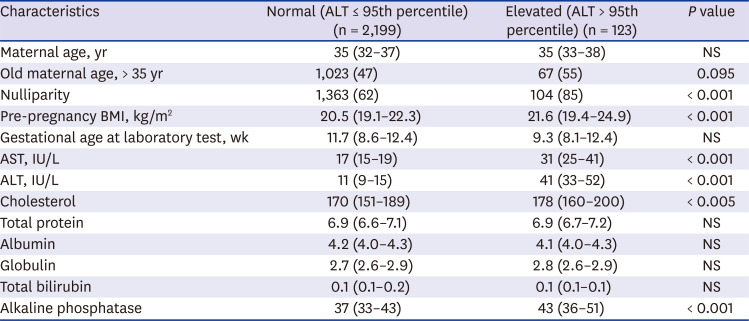
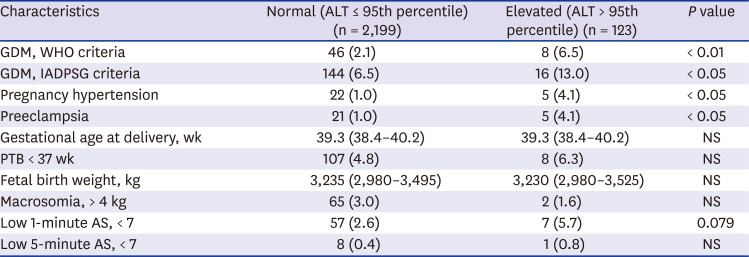
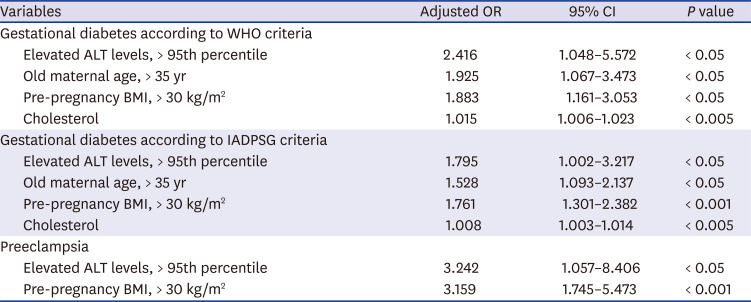




 PDF
PDF Citation
Citation Print
Print



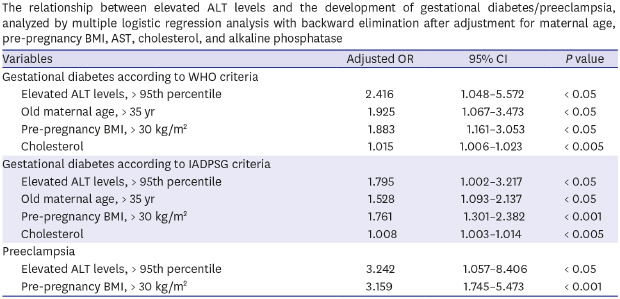
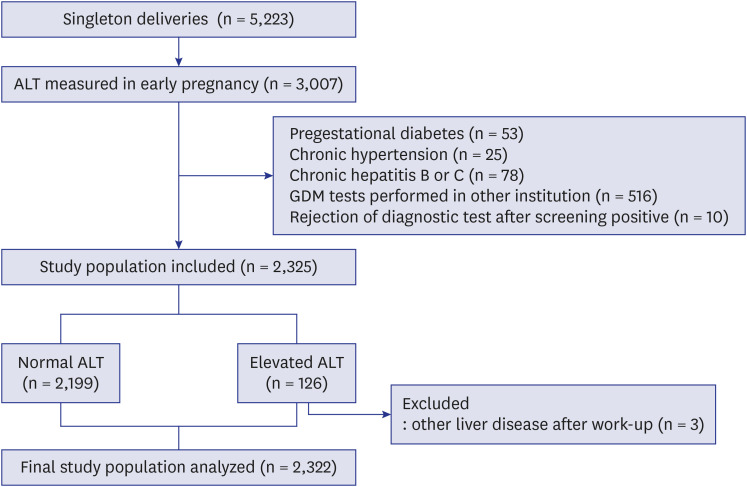
 XML Download
XML Download